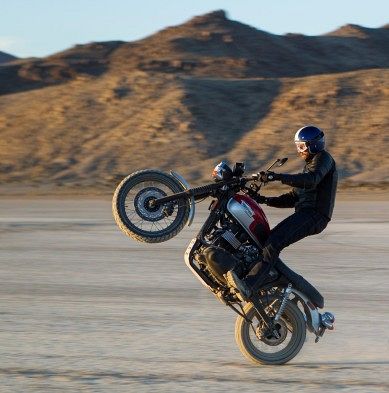Physically, wheelies are the result of acceleration combined with a short wheelbase and a relatively high center of gravity. Off-road, a wheelie is useful in letting you hit troublesome terrain with the back wheel, rather than have the bars yanked out of your hands by hitting that log or boulder with the front.
Years ago, I was impressed to see the rider of a 650 Triumph drag bike lift the front a couple of inches off the line and then hold it there through first gear. That’s a power wheelie.
What I think of as a “style wheelie” is the practice of pulling the front up way up so the CG of rider and bike is balanced directly over the rear tire’s footprint. The rider can stay in this state by applying a series of little throttle-grunts, but almost zero acceleration is taking place, so this is a circus balancing act, and has nothing to do with power.
In 2004 Valentino Rossi said, “The wheelie is the enemy.” He meant that once the front starts to lift, you have reached the upper limit of your bike’s acceleration. The higher the front wheel lifts, the closer you get to flipping over backward. Maximum acceleration takes place with the front tire barely kissing the pavement.
The Triumph rider I saw at the strip had a powerband smooth enough to controllably hold the front wheel at a constant level, but as you tune engines for higher power, their torque curves become mountain ranges, and even a throttle-genius can no longer hold the front tire at the low, constant height that maximizes acceleration. Instead, the front end leaps unpredictably for the sky as your engine’s torque spikes. This is why electronic anti-wheelie systems came into being—first for MotoGP, and now for high-power sportbikes.
When you put on a big sticky drag slick, you can generate so much forward thrust that lifting the front becomes trivial. To use the added grip without acceleration-sapping wheelies, you must (1) move heavy components forward, (2) extend the wheelbase to achieve the same thing, and (3) lower the major masses as far as Mother Earth permits. All these measures, by lowering the CG and moving it forward, increase the rear wheel torque that it takes to lift the front end. Result: That massive torque shoots you forward instead of popping the front end up.
Drag racers know that if the front end comes up more than a couple of inches, the run is trashed. Racer/tester Jay Gleason used the clutch to control this. If the engine bogged, light pressure on the clutch lever brought it back to its torque peak. And if the front end started to rise too high or too fast, light pressure on the clutch lever restored the condition for max acceleration, with the front tire barely lifted.
You might buy a stack of clutch plates learning to do this, but experience is not free!











24
Comment